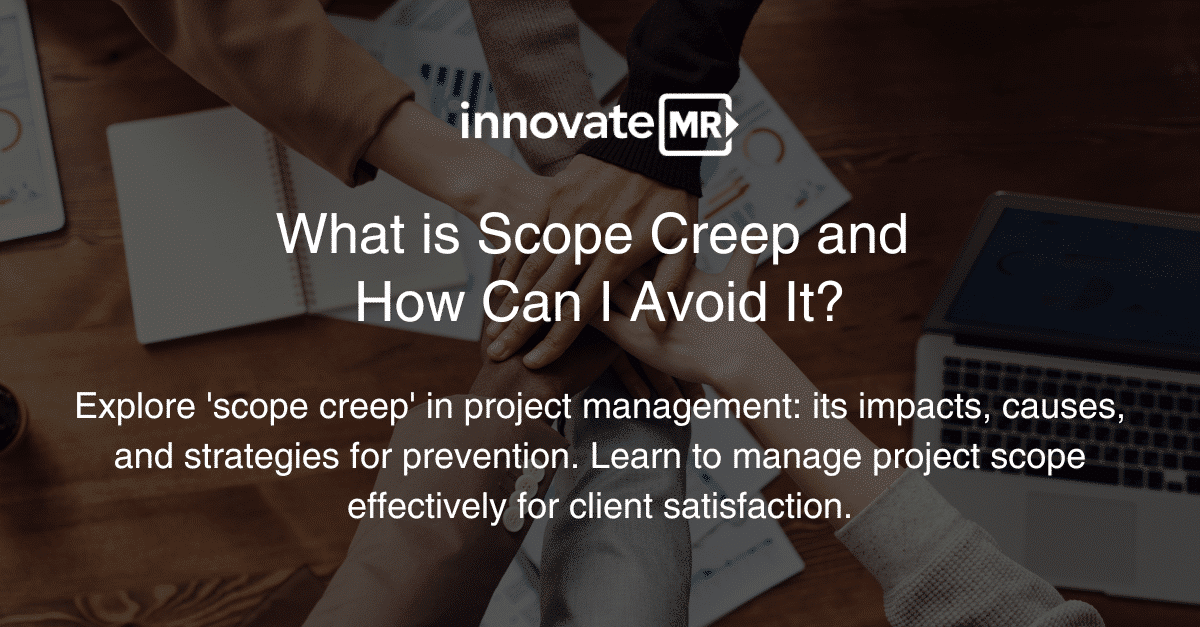
What is Scope Creep?
When a project’s requirements extend beyond its original plan, project managers and research teams can experience scope creep. Scope creep is a common challenge that can lead to increased costs, result in missed deadlines, and decreased quality. To combat this, teams can implement scope change control or the process of managing and controlling changes to a project’s scope to prevent scope creep. This involves establishing a formal process for evaluating and approving changes to the project’s scope in advance and ensuring that any changes are evaluated in terms of their impact on the project’s timeline, budget, and overall goals. Effective scope change control begins with establishing a clear project scope, including a detailed project plan that outlines the project’s goals, objectives, deliverables, and team time commitment. This plan should be shared with all stakeholders and be regularly updated throughout the project’s lifecycle. When changes to the project’s scope are requested, they should be evaluated carefully through a formal scope change control process. This process should involve a clear definition of the change, why the change is being made, an assessment of its impact on the project’s timeline, budget, and goals, and final approval from all relevant stakeholders.
Why Does Scope Creep Happen?
Scope creep may occur for many reasons. Clients may need additional features or changes, team members may not fully have realized the project’s requirements, or external factors such as market changes; may impact the project’s scope. Regardless of the reason, it’s important to manage changes to the project’s scope in a controlled and structured manner to ensure effective team management and client success.

An Example of Scope Creep
Let’s consider an example of scope creep in action where a team may need to implement scope creep control. Imagine that a market research project is initially scoped to conduct focus groups and online surveys to gather feedback on a new consumer product. The project team estimates that this work will take six weeks to complete and will cost a certain amount specific to the target audience requirements.
Client Requests Additional Research
As the project progresses, the client requests additional research activities, such as conducting in-depth interviews with specific participants and conducting secondary research on competitor products. The project team agrees to these changes to ensure the client is satisfied with their services, but they don’t update the project plan or budget to reflect the additional work.
Delays Affect Client’s Budget and Timeline
As a result, the project takes longer than expected to complete and the costs exceed the initial estimate, placing the final price tag outside of the client’s budget. The team is also unable to meet the original deadline, which impacts the client’s ability to use the research insights in a timely manner.
Scope Creep Caused by Inadequate Project Planning
In this scenario, scope creep occurred because the project team didn’t effectively manage changes to the project’s scope and instead added it to their current workload. They agreed to the client’s additional research activities without fully considering their impact on the project’s timeline, budget, and overall goals. The team also didn’t update the project plan to reflect the additional work, which made it difficult to manage the project’s timeline and budget effectively.

How to Avoid Scope Creep
1. Define the scope of the process:
The first step in preventing scope creep is to establish a clear path to completion for the project. This includes defining the project’s specific goals, objectives, deliverables, and timelines. This should be meticulously documented in a project plan that is shared with all stakeholders, agreed upon ahead of time, and regularly reviewed and updated throughout the project.
2. Implement a formal process for scope changes:
Once the project scope is established, any changes should be reviewed and approved through a formal scope change control process. This process should include a clear definition of the change, an assessment of its impact on the project’s scope, timeline, and budget, and approval from all relevant stakeholders. Changes should be evaluated in terms of their impact on the project’s overall goals and objectives, as well as their feasibility and cost. This better manages expectations from both the client and research teams.
3. Communicate clearly and often:
Effective communication is also critical in preventing scope creep and implementing scope creep control. All stakeholders should be informed of the project’s scope and any potential changes, as well as regular updates to keep everyone on the same page. This includes communicating changes in a timely manner, providing clear and concise information, and being transparent about any potential impacts on the project.
4. Keep on top of potential updates:
Finally, it’s important to monitor the project’s progress and adjust as needed. Regular status reports and checkpoints can help identify potential scope creep before it becomes a major issue. Teams should also be encouraged to speak up if they see any potential problems or challenges that could impact the project’s scope and work to proactively discuss concerns with the client.
Conclusion
In summary, scope creep can be a significant challenge for project management teams as they work to meet all client needs, but it can be managed and prevented through effective scope change control. By understanding the causes of scope creep and implementing effective strategies to recognize and prevent it, you can minimize the risks and keep your project on track or expand into new opportunities. Establishing a clear project scope, using a formal change control process, communicating effectively with stakeholders, and monitoring the project’s progress can all help prevent scope creep and ensure the project is successful and the client is happy
About InnovateMR – InnovateMR is a full-service sampling and ResTech company that delivers faster, quality insights from business and consumer audiences utilizing cutting-edge technologies to support agile research. As industry pioneers, InnovateMR provides world-class end-to-end survey programming, targeted international sampling, qualitative and quantitative insights, and customized consultation services to support informed, data-driven strategies, and identify growth opportunities. Known for their celebrated status in customer service and results, InnovateMR combines boutique-level service with extensive global reach to achieve partner success.


